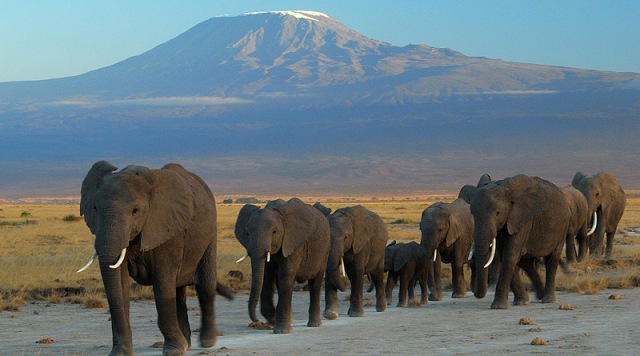Day 1 -Nairobi/Amboseli
Departing Nairobi in the morning, you drive south to Amboseli National reserve at the foot of snowcapped Mt. Kilimanjaro, Africa’s highest peak to arrive in time for lunch, followed later by an afternoon game drive. Dinner and overnight at Kibo Safari Camp.
Day 2 – Amboseli National Park

You spend the day game viewing in the park with extensive morning and afternoon game drives. Meals and overnight at the Camp.
Amboseli National park is one of the most popular wildlife sanctuaries in Kenya. It is situated close to Kenya- Tanzania border, The Park lies at the foot of Mt. Kilimanjaro, the highest mountain in Africa (5,896m) whose snow-capped summit presents a splendid view on clear days. Amboseli National Park is often referred to as “The home of Elephants’ some of the largest Elephant herds are found here. The Game Park also contains vast groups of Zebras, Wildebeests, Giraffes, Buffalos, Hippos and Antelopes. Also to be found in Amboseli are lions, leopards, Cheetahs, Rhinos and many species of plain game.
Day 3 –Amboseli/Lake Manyara
After breakfast, you depart for the Namanga border and proceed to Lake Manyara National park via Arusha to arrive in time for a late afternoon game drive to explore the park, Regardless of the direction you approach Manyara from, the view is always fantastic. Dinner and overnight at a campsite.
Day 4 -Manyara/Serengeti
You spend the morning game viewing in the park before you proceed to Serengeti National park
(4 hrs), viewing game as you drive to the Seronera area. Dinner and overnight at a Seronera campsite.
Day 5 -Serengeti
You spend the day exploring the park in search of the big 5 among other game. Meals & overnight at the Campsite.
Serengeti is Africa’s most famous and Tanzania’s largest park covering 14,736 sq km and is adjoining with the Masai Mara National reserve in Kenya. With a wildebeest population of about 2 million and several other hoofed species (which include zebra, Thomson’s gazelle, impala, topi, Grants gazelle, Kongoni, Eland, Kirk’s dikdik, klipspringer, roan, Oryx, oribi, waterbuck, buffalo, giraffe and warthog), the Serengeti is sure to attract a string of prey such as lion, leopard, cheetah, hyena, golden jackals and bat eared foxes. Elephants are relatively scarce and the few remaining black rhinoceros are restricted to the Moru Koppies area.
Serengeti also offers rewarding bird viewing with ostrich and kori bustard being common, a variety of larks, finches, and raptors can be seen but the most distinctive small bird is the lilac breasted roller.
Day 6 –Serengeti/Ngorongoro
After breakfast, you depart for the magnificent Ngorongoro Conservation Area and descend into the crater for an afternoon crater tour with packed lunches.
The Ngorongoro Crater is often called ‘Africa’s Eden’ and the ‘8th Natural Wonder of the World,’ a visit to the crater is a main drawcard for tourists coming to Tanzania and a definite world-class attraction. The Ngorongoro Conservation Area (NCA) is home of Ngorongoro Crater. It was formed some 2.5 million years ago from a volcanic mountain sinking due to inactivity, and was initially thought to be higher than Tanzania’s famousKilimanjaro. The crater has evolved into a unique and integral part of Tanzania’s eco-system. The crater is actually a caldera, measures 22.5 km’s across and the rim walls stand 600m high. Views from within and from the rim are breathtaking (as can be seen from the picture). The crater houses 30,000 animals and a large variety of birds, which rarely move from the area due to the availability of water through wet and dry seasons.
Thereafter, ascend and drive to a Karatu Campsite for dinner and overnight.
Day 7 -Ngorongoro/Tarangire
After breakfast, you drive to Tarangire National Park and spend the day exploring the park, which is also known as ‘the elephant park in Tanzania’. The landscape of the park is made up of seasonal marshes and a seemingly endless tree savannah with its mighty baobab trees. The dry season runs from July until October and this is perhaps the best time to visit the park. The reason for this is that the Tarangire River is the only permanent source of water during this time and therefore the wildlife tends to concentrate in this area. You can therefore observe the herds of buffalos and wildebeests as they come down to the river for drinking. Other animals of the park that also assemble in this area are lions, leopards, zebras, antelopes and gazelles. Meals and overnight at a campsite.
Day 8 -Tarangire/Arusha/Nairobi
Early morning game drive to further explore the park and after breakfast, you depart for Arusha to connect with the afternoon shuttle bus to Nairobi.
